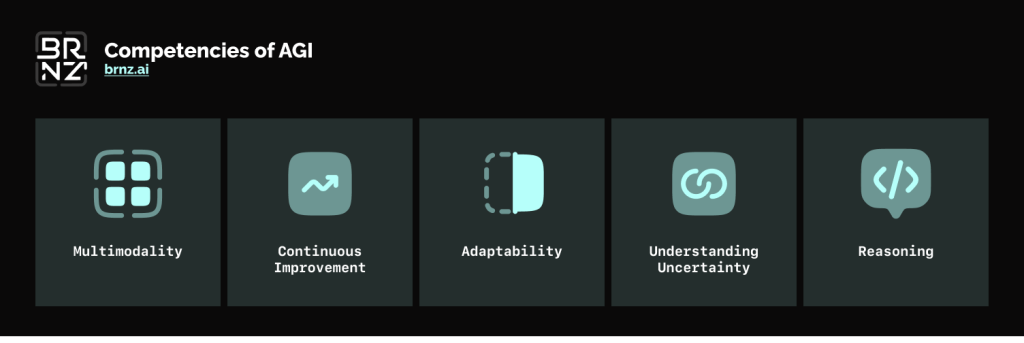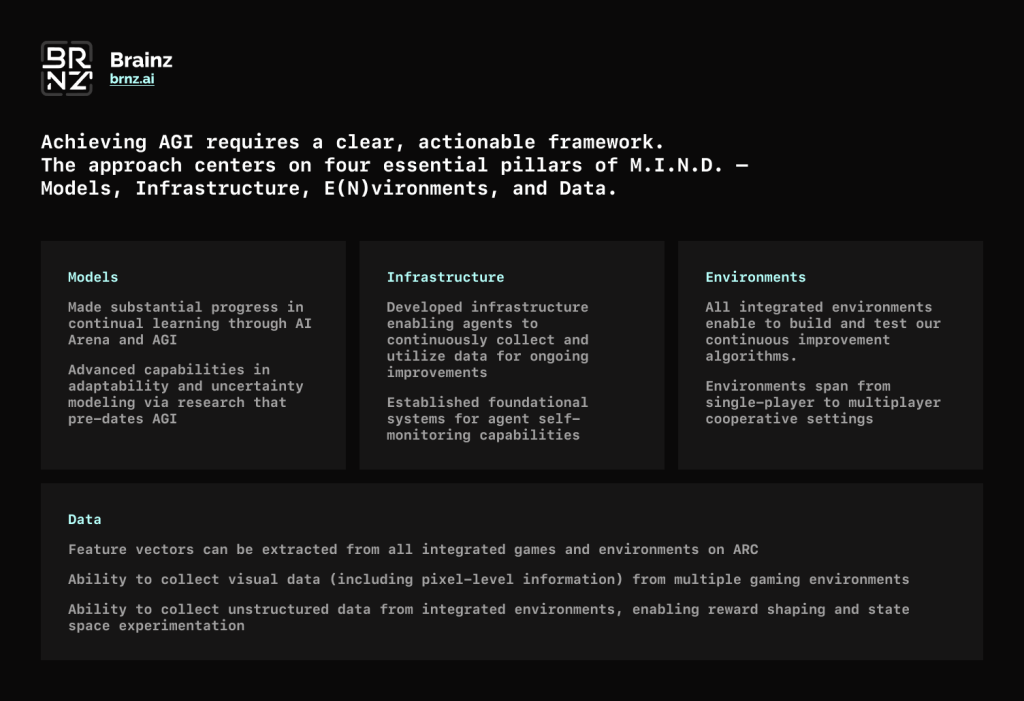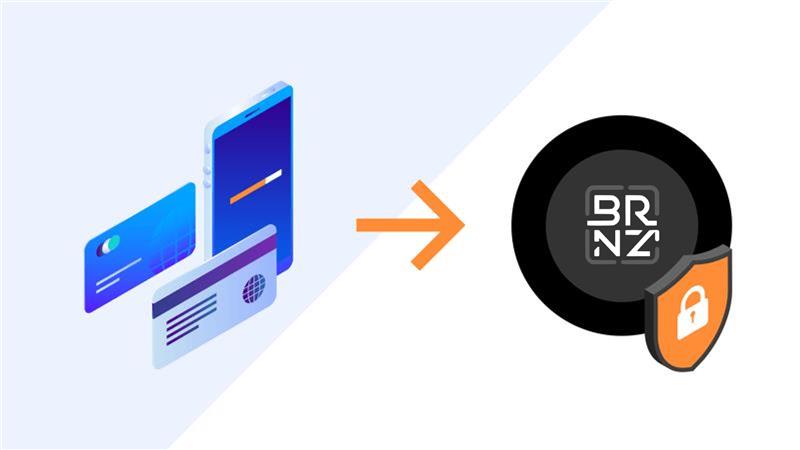Introduction
Artificial General Intelligence (AGI) is the most important goal in AI. Every breakthrough—from new activation functions to innovative architectures—brings us one step closer to this singular vision. It’s not just the next chapter of AI; it’s the ultimate unlock for human progress.
At BRAINZ, we believe gaming provides the perfect testbed to tackle this challenge. Games can reflect the complexity of the real world, with dynamic rules, and limitless variability that push AI to think beyond static tasks —all essential for AGI.
Industry leaders like Elon Musk (xAI) and Demis Hassabis (DeepMind) already recognize this.
Musk’s recent comments about gaming initiatives at xAI demonstrate games’ essential role in training and testing general intelligence systems.
Meanwhile, DeepMind’s Genie 2 engine and ongoing research in gaming environments reveal a broader vision:
“It was never, obviously, our intent to just focus only on games. Games were the gateway for us to building and improving out these general purpose algorithms that could learn in AlphaZero’s case for any, to play a game, from scratch without any of the rules or anything. And so we thought once we were to, if we were to crack games in that general way, we should be able to apply that algorithm to real world problems that have the same type of properties…” – Demis Hassabis
For these visionaries, the intersection of AI and gaming is more than entertainment—it’s a strategic approach to achieving AGI. AI agents trained in these environments won’t just master games; they’ll reason, adapt, and ultimately solve real-world challenges.
This lite-paper outlines vision and roadmap, detailing how gaming, $NRN, and our structured framework of Models, Infrastructure, E(N)vironments, and Data (M.I.N.D.) come together to bridge the gap from narrow AI to AGI.
The Building Blocks of AGI
AGI means different things to different people. It defines it through two critical dimensions: the competencies AGI must possess and the contexts it must master. Together, these building blocks form the foundation of what we believe AGI should achieve.
Competencies of AGI
To achieve true general intelligence, an AI must exhibit the following core capabilities:
-
Multimodality: The ability to process and integrate different inputs—visuals, audio, text, and arbitrary features —into a cohesive understanding.
-
Continuous Improvement: AGI should learn and improve with every new interaction, evolving incrementally over time without forgetting what it previously learned.
-
Adaptability: True intelligence shines when the rules change. AGI must quickly respond to changes in existing environments, handling tasks it has never seen before, and encountering new environments.
-
Understanding Uncertainty: Intelligence isn’t just about knowing; it’s about recognizing when you don’t know. AGI must identify novel situations and adjust its approach without explicit instructions.
-
Reasoning: AGI needs more than simple pattern recognition. It must understand cause and effect, allowing it to reason through problems, make predictions, and create solutions that were unseen in its training.

Contexts for AGI
Even with the right competencies, AGI must also excel in diverse and challenging environments. These are the contexts we believe are essential for testing and refining AGI:
-
Multi-Agent Collaboration: In multiplayer environments, AGI must coordinate with others, whether they are humans or AI agents. This challenges its ability to strategize, communicate, and compete effectively.
-
Complex and Non-Stationary Environments: Worlds where the rules evolve, tasks shift, and the other agents are constantly changing. AGI should recognize when things are changing and swiftly adapt.
-
Open-World Complexity: Open-world environments test AGI’s capacity to discover new objectives, prioritize tasks, and manage unexpected challenges—all while juggling multiple goals.
-
Long-Term Planning: Many tasks require looking beyond immediate rewards to achieve greater success. AGI should excel at executing multi-step plans with sparse feedback—a skill that most AI struggles with today.
Where We Are Today
Achieving AGI requires a clear, actionable framework. The approach centers on four essential pillars of M.I.N.D. — Models, Infrastructure, E(N)vironments, and Data.

With AI Arena and AGI, it has established foundational capabilities while creating a platform for future innovation. Here’s where we stand today:
Models:
-
Made substantial progress in continual learning through AI Arena and AGI
-
Advanced capabilities in adaptability and uncertainty modeling via research that pre-dates AGI
Infrastructure:
-
Developed infrastructure enabling agents to continuously collect and utilize data for ongoing improvements
-
Established foundational systems for agent self-monitoring capabilities
Environments:
-
All integrated environments enable to build and test our continuous improvement algorithms.
-
Environments span from single-player to multiplayer cooperative settings
Data:
-
Feature vectors can be extracted from all integrated games and environments on ARC
-
Ability to collect visual data (including pixel-level information) from multiple gaming environments
-
Ability to collect unstructured data from integrated environments, enabling reward shaping and state space experimentation
The Road Ahead
While we’ve established a strong foundation, achieving AGI requires addressing key capability gaps. Our roadmap extends beyond AGI to build an open ecosystem that accelerates development through gaming.
Identified Gaps
To move closer to AGI, it will start by focusing on the following critical gaps:
-
Reasoning: Develop models capable of understanding causality and extrapolating knowledge beyond patterns found in the training data.
-
Hierarchical Machine Learning (HML): Advance research in HML, an approach to machine learning where systems are organized into modules, each responsible for learning at a specific level of abstraction.
-
Uncertainty Handling: Equip AI systems to recognize and adapt to unknown scenarios with caution and precision.
Roadmap Priorities
To address these challenges, these are pursuing a strategic combination of internal innovation, partnerships, and community collaboration:
-
Models: Collaborate with researchers and developers to create models capable of reasoning, adaptability, and generalization. Launch a competition platform in Q1 2025 to incentivize model innovations across a variety of different environments.
-
Infrastructure: Partner with AI infrastructure providers to meet the growing computational demands of $NRN’s expanding ecosystem. Build scalable systems to support continuous training and handle the increasing complexity of environments.
-
Environments: Create unique game worlds that test AGI’s ability to plan long-term, collaborate with others, and manage unexpected challenges. Partner with projects specializing in modalities such as vision, audio, and language to complement ARC’s expertise in behavioral modeling.
-
Data: Partner with game developers to integrate ARC SDKs and generate diverse, high-quality datasets from dynamic gaming environments. Focus on fast-to-market games to scale quickly.
An Invitation to Join Us
The pursuit of AGI is a monumental challenge, requiring collaboration across contributors. The roadmap outlined in this lite-paper provides a blueprint for progress, but the real power lies in the community we build. Whether through partnerships, research, or tool development, your contributions are essential to shaping a future where AGI becomes reality.
Start building your agentic future today! One place is available for the start in 2025. Contact us now at hi@brnz.ai!



